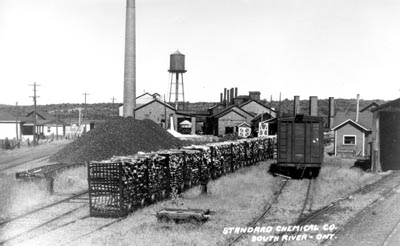 |
May 18, 2000
South River nestles on both sides of Hwy. 11
|
The town of South River has a population of about 1,000 and is situated
on the river that gives it its name. Like other communities on the South
River and its tributaries it is located where it is because of the access
to water power and because the railway from Toronto crossed the river there
in the 1880s. South River is nestled on both sides of Highway 11, 50 kilometres
south of North Bay between Machar Township and the unincorporated township
of Laurier.
In the tourist season the population of the area increases significantly.
Roads lead to Mikisew Provincial Park to the West and the Algonquin Park
access point to the East.
The early development of South River was based on the harvesting of
the forests. The Fraser Lumber Company took out squared timber on the South
River from Laurier Township and into what became Algonquin Park starting
in the 1860s. They cleared the river, established water control dams, and
log chutes around rapids. J. R. Booth and others cut in Machar township
and shared the maintenance of the river.
Evokes images
Everett Kirton in his History of Northern Parry Sound District (1962) provides
some history of early South River. His description of the surveyors arriving
in the bush to survey the railway corridor evokes remarkable images of
the time. He states that "The surveyors’ supplies and equipment were hauled
by teams and sleighs from Rosseau to Bummer’s Roost (on the Nipissing Colonization
Road 20 kilometres to the east) thence by dog team and toboggans over low
lying land across to South River, crossing Dette and Eagle Lakes."
Mr. Kirton also records that South River separated from Machar Township
and was incorporated in 1907, with the W. J. Ard as the first Reeve. One
of the first businesses was the South River Mercantile Company partly owned
by Ard.
First settlers
Robert Carter and his wife were the first settlers in the area in 1881
and opened a general store in 1885. There were early hotels, a bank, a
butcher shop and a jeweller.
The South River was harnessed to drive a sawmill and grist mill. By
1908 hydroelectric power was being generated for use a few hours a day
in the area.
The South River Lumber Company was established early in South River
and shipped lumber on the Grand Trunk Railway. This company also cut lumber
for other logging operations that did not have a sawmill, especially the
large Turner Company.
The largest employer in South River for decades was the Standard Chemical
Company. This was one of the six plants in Ontario built to meet the need
for wood alcohol, other distillates and charcoal in those early years.
Workers brought in
When there were not enough local workers A. F. Cooper, the Woods Manager,
brought in Italian and Finish workers who became jobbers cutting their
cordwood. The Finish workers ran their own camps and were early leaders
in the labour movement. A strike in 1934 brought better wages and working
conditions.
 |
This post card shows the Standard Chemical Company charcoal
factory.(photo courtesy of Dixie Hogan, Powassan) |
Standard Chemical established a standard-gauge railway to haul its cordwood.
When the distillate and charcoal business waned the company established
a highly productive and separate lumber operation in the town. Mr. Cooper
brought in his son, Orlo, to expand the railway to bring in the necessary
logs. The railway eventually went 40 kilometres east to Round Lake then
south along the south arm of the South River to Winifred Lake in Algonquin
Park.
They purchased two 50-ton Climax engines and a Barnhart steam log loader
for the railway. They later purchased a 70-ton Shay locomotive.
During the second world war German prisoners of war were used at Camp
10 to cut logs. When truck transportation became economical in 1946, the
rails were pulled up and a road built on the railbed for hauling logs and
transporting people and supplies. The Shay locomotive was sold to the Abitibi
Power and Paper Company were it was used into the 1970s. It was later donated
to the town of Iroquois Falls where it was restored and placed beside the
train station as a centerpiece of the town’s museum (For further information
on the Standard Chemical Company Railway see The Fossmill Story.)
Basis for book
The story of the Standard Chemical Company may someday be the basis of
a book. I have recorded several interviews with some of the former workers
and have a collection of photographs a couple of which appear here. If
anyone has any information they wish to share I would be pleased to hear
from him or her.
 |
This photo shows a teamster with his team ready to pull
a load of cordwood into a kiln. (photo courtesy of Dixie Hogan, Powassan) |
Two other items, that I will expand upon next, week are the restoration
of the CNR train station and the Machar Township history book Journey Through
Whispering Pines—A History of the Township of Machar, 1875-2000 due to
be available later this month. South River was in Machar Township until
South River incorporated in 1907 and this early history is included in
the book.
The railway station closed 1986 and is still a drop-off and pickup stop
on the CNR.
A local Heritage Improvement and Preservation Committee, supported by
South River and Machar, has had a planning report prepared to attempt to
"transform the station house into a modernized and renovated train station
that would preserve the history of the Almaguin Highlands area and potentially
provide a center for cultural and historical activities." It looks as if
this project is going ahead when details of the acquisition from CNR are
complete.
Heritage Perspective Home Page
|

![]() Past
Forward is now on Facebook "LIKE" us to keep in touch
Past
Forward is now on Facebook "LIKE" us to keep in touch